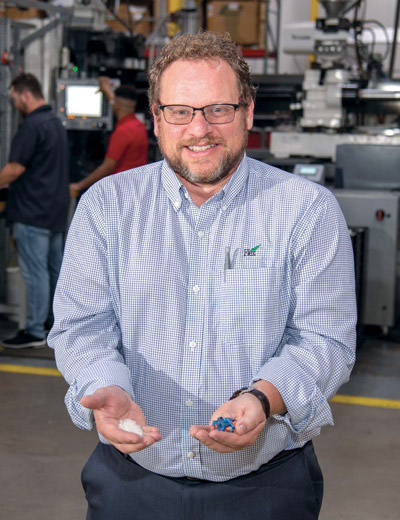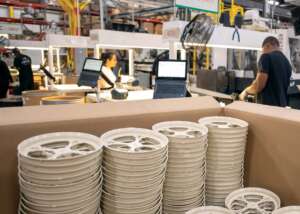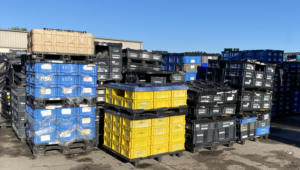Circular Lifecycle
Repurposed Recycled Industrial Plastics in Automated Manufacturing
PolyFlex Products has developed a circular lifecycle for plastics that brings custom recycled plastics up to ASTM standards so they can be used again in manufacturing automation. As part of its zero-waste programs, PolyFlex is recycling the Industrial plastics it uses in manufacturing automation and repurposing them for reuse in its plants. As the recycled plastics meet ASTM standards, they have the structural integrity to meet factory performance standards.

“It’s a new perspective on the product lifecycle,“ says Ken Bylo, executive vice president and partner, PolyFlex Products. “With this initiative, we’re recasting the accepted product lifecycle parameters from cradle-to-grave to cradle-to-grave-to-cradle again. The goal is to repurpose and reuse industrial plastics that were designed for durable use in automated manufacturing. This saves resources and keeps these viable materials out of landfills.”
The circular product lifecycle differs from downcycling in method and product yield and utility. In downcycling, recycled products are created for a level of use that is downgraded from their original purpose. For PolyFlex, in the circular product lifecycle, recycled industrial plastics previously used in manufacturing automation are designed and repurposed for high-level use in the plants.
 For example, a bin that was created with a polymer designed to withstand the punishment of constantly carrying heavy-duty materials or objects during the manufacturing process will experience natural degradation over time from customary wear and tear and from environmental exposure. At this lifecycle stage, it will exhibit properties that are not compatible with its original ASTM standards, rendering it unsuitable for its original use. These plastics are ground down using a specified regrind process to break them down into very small pieces, or pellets, approximately 6mm in size, that are ready for use to create new plastic products for automated manufacturing. A percentage of additive materials is added to the regrind to raise the specs of these repurposed materials to ASTM standards for the identified use.
For example, a bin that was created with a polymer designed to withstand the punishment of constantly carrying heavy-duty materials or objects during the manufacturing process will experience natural degradation over time from customary wear and tear and from environmental exposure. At this lifecycle stage, it will exhibit properties that are not compatible with its original ASTM standards, rendering it unsuitable for its original use. These plastics are ground down using a specified regrind process to break them down into very small pieces, or pellets, approximately 6mm in size, that are ready for use to create new plastic products for automated manufacturing. A percentage of additive materials is added to the regrind to raise the specs of these repurposed materials to ASTM standards for the identified use.
.
“At PolyFlex, we are working to overcome the stigma surrounding the use of recycled industrial plastics in automated manufacturing,” says Bylo. “Our approach and experience, as well as specific formulas used throughout the regrind process, ensures that the material is of the highest quality and that minimal additional degrading takes place by controlling the heat, which also influences the amount of additives that are added for the product to meet ASTM standards. And, we are using these recycled products in our own automated manufacturing facilities.”

PolyFlex’s new repurposed industrial plastics are a budding revenue stream. In addition to using them in their facilities, PolyFlex has an agreement with a global automaker to work with their obsolete industrial plastics used in their manufacturing automation processes to repurpose and reuse the plastics. It also is in talks with a global Tier 1 automotive supplier to provide similar services.
